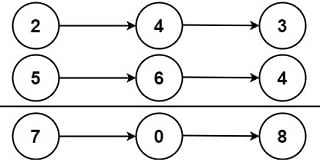Leetcode 2. How To Add Two Numbers Represented As Linked Lists
Add two linked lists representing non-negative integers in reverse order, handling carry and extending results if needed.
Problem statement
You have two linked lists that represent non-negative integers. The digits of these numbers are stored in reverse order, with each node containing a single digit.
Your task is to add the two numbers represented by these linked lists and return the result as a new linked list.
You can assume that the two numbers don't have leading zeros, except for the number 0 itself.
Example 1

Input: l1 = [2,4,3], l2 = [5,6,4]
Output: [7,0,8]
Explanation: 342 + 465 = 807.
Example 2
Input: l1 = [0], l2 = [0]
Output: [0]
Example 3
Input: l1 = [9,9,9,9,9,9,9], l2 = [9,9,9,9]
Output: [8,9,9,9,0,0,0,1]
Constraints
- The number of nodes in each linked list is in the range
[1, 100]. 0 <= Node.val <= 9.- It is guaranteed that the list represents a number that does not have leading zeros.
Solution: Addition With Remember
Perform the school addition calculation and store the result in one of the lists.
Without loss of generality, let us store the result in l1. Then you might need to extend it when l2 is longer than l1 and when the result requires one additional node (Example 3).
Code
#include <iostream>
struct ListNode {
int val;
ListNode *next;
ListNode() : val(0), next(nullptr) {}
ListNode(int x) : val(x), next(nullptr) {}
ListNode(int x, ListNode *next) : val(x), next(next) {}
};
ListNode* addTwoNumbers(ListNode* l1, ListNode* l2) {
// dummy node to hook the head of the list
ListNode prehead;
// let's use l1's nodes to store result
ListNode* node = l1;
prehead.next = node;
int sum = 0;
while (node) {
// perform the addition
if (l1) {
sum += l1->val;
l1 = l1->next;
}
if (l2) {
sum += l2->val;
l2 = l2->next;
}
node->val = sum % 10;
// keep track the carry
sum /= 10;
if (!l1) { // l1 ends
if (l2) { // l1 is shorter than l2
node->next = l2;
} else if (sum == 1) {
// both l1 and l2 end but the remember is not zero
ListNode* newNode = new ListNode(sum);
node->next = newNode;
}
}
node = node->next;
}
return prehead.next;
}
void printResult(ListNode* l) {
std::cout << "[";
while (l) {
std::cout << l->val << ",";
l = l->next;
}
std::cout << "]\n";
}
int main() {
{
ListNode three(3);
ListNode four1(4, &three);
ListNode two(2, &four1);
ListNode four2(4);
ListNode six(6, &four2);
ListNode five(5, &six);
printResult(addTwoNumbers(&two, &five));
}
{
ListNode zero1(0);
ListNode zero2(0);
printResult(addTwoNumbers(&zero1, &zero2));
}
{
ListNode nine0(9);
ListNode nine1(9, &nine0);
ListNode nine2(9, &nine1);
ListNode nine3(9, &nine2);
ListNode nine4(9, &nine3);
ListNode nine5(9, &nine4);
ListNode nine6(9, &nine5);
ListNode nine7(9);
ListNode nine8(9, &nine7);
ListNode nine9(9, &nine8);
ListNode nine10(9, &nine9);
printResult(addTwoNumbers(&nine6, &nine10));
}
}
Output:
[7,0,8,]
[0,]
[8,9,9,9,0,0,0,1,]
Code explanation
- The code creates a dummy
preheadnode, which serves as the starting point of the resulting linked list. Thepreheadnode is used to simplify the code for handling the first node and to ensure that the final result can be easily accessed. - A pointer
nodeis initialized to point to thel1list. This pointer will be used to construct the resulting linked list, andl1will be updated to store the result. - The code sets the
nextpointer of thepreheadnode to point to thenode(i.e.,l1). This effectively hooks the resulting linked list to thepreheadnode. -
Inside the main loop:
- A condition checks if
l1is notnullptr. If it's notnullptr, it means there are more digits inl1to process. The code adds the value of the current node inl1to thesumand advancesl1to the next node. - Similarly, this condition checks if
l2is notnullptr. If it's notnullptr, it means there are more digits inl2to process. The code adds the value of the current node inl2to thesumand advancesl2to the next node. 5.node->val = sum % 10assigns the least significant digit of thesumto thevalof the current node pointed to bynode. It calculates the remainder ofsumwhen divided by 10, which represents the value of the current digit. 6.sum /= 10updates thesumby removing the least significant digit. It represents the carry value to be added to the next digits. 7. The code handles different scenarios for the termination of the loop:
- If
l1has reached its end (i.e.,l1isnullptr), it meansl1is shorter thanl2or bothl1andl2have ended. In this case, the code checks ifl2still has remaining digits. Ifl2has remaining digits, it appends the remaining part ofl2to the result by updating thenextpointer of the currentnodeto point tol2. - If both
l1andl2have ended, but there is a carry value of 1, a newListNodeis created with a value of 1, and it's appended to the result by updating thenextpointer of the currentnode. 8. Thenodepointer is moved to the next node in the resulting linked list for the next iteration of the loop. 9. After the loop completes, the resulting linked list, starting from theprehead, contains the sum of the two input numbers represented as linked lists. 10. The function returnsprehead.next, which is the head of the resulting linked list.
- A condition checks if
Complexity
This solution efficiently adds two numbers represented as linked lists by iterating through both linked lists, digit by digit, and calculating the sum and carry. It also handles different scenarios for the lengths of the input lists and any remaining carry values.
- Runtime:
O(N), whereN = max(l1.length, l2.length). - Extra space:
O(1).